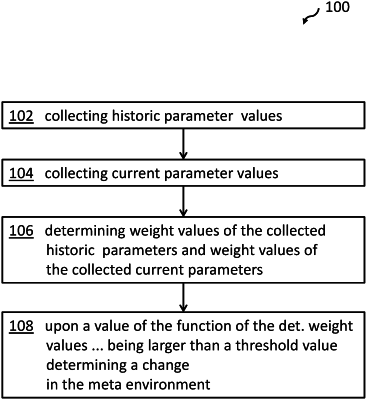| CPC A63F 13/798 (2014.09) [A63F 13/795 (2014.09); A63F 2300/5566 (2013.01); A63F 2300/558 (2013.01)] | 14 Claims |

|
1. A computer-implemented method for detecting a change in a meta-environment, the method comprising:
collecting historic parameter values from at least one actor being active in the meta-environment, wherein each of the at least one actor has a set of abilities represented by parameters relating to the collected historic parameter values;
collecting current parameter values from the at least one actor being active in the meta-environment;
determining weight values of the collected historic parameter values and weight values of the collected current parameter values;
determining a detection of the change in the meta-environment upon determining a value of a function of the determined weight values of the collected historic parameter values and the weight values of the collected current parameter values being larger than a predefined threshold value;
generating first new parameter values using the collected current parameter values, wherein the generating the first new parameter values using the collected current parameter values comprises:
extrapolating the collected current parameter values into the future as first extrapolated parameter values; and
building a ranking of the first new parameter values associated with the at least one actor by a covariance dependency value of the first extrapolated parameter values;
imputing the first new parameter values into the collected historic parameter values, wherein the imputing the first new parameter values includes replacing the collected historic parameter values with newly forecasted parameter values;
forecasting second extrapolated parameter values for a parameter of the parameters relating to the collected historic parameter values with the least covariance dependency value to other parameters using the first extrapolated parameter values;
building time buckets for the first extrapolated parameter values and the second extrapolated parameter values;
training forecasting models for third parameter values for the parameters relating to the collected historic parameter values with a next least covariance dependency value to other parameters, using the first extrapolated parameter values and the second extrapolated parameter values;
building a set of variable values for each of the trained forecasting models;
using the set of variable values for each of the trained forecasting models that represent statuses of the trained forecasting models at a later point in time; and
using the trained forecasting models to generate the first new parameter values.
|